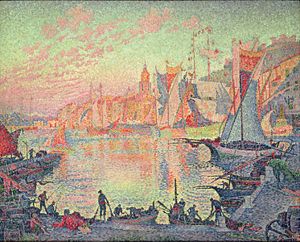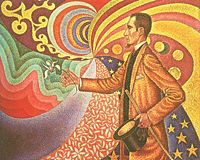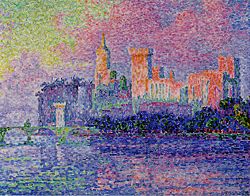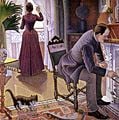Difference between revisions of "Paul Signac" - New World Encyclopedia
(fixed a link) |
|||
| Line 1: | Line 1: | ||
{{Contracted}}{{Started}} | {{Contracted}}{{Started}} | ||
[[Image:Signac The Port of Saint-Tropez.jpg|thumb|right|300px|''The Port of Saint-Tropez'', oil on canvas, 1901]] | [[Image:Signac The Port of Saint-Tropez.jpg|thumb|right|300px|''The Port of Saint-Tropez'', oil on canvas, 1901]] | ||
| − | '''Paul Signac''' ([[November 11]], [[1863]] - [[August 15]], [[1935]]) was a [[France|French]] [[Neo-impressionism|neo-impressionist]] [[Painting|painter]] who, working with [[Georges-Pierre Seurat]], helped develop the [[pointillism|pointillist]] style. | + | '''Paul Signac''' ([[November 11]], [[1863]] - [[August 15]], [[1935]]) was a [[France|French]] [[Neo-impressionism|neo-impressionist]] [[Painting|painter]] who, working with [[Georges-Pierre Seurat]], helped develop the [[pointillism|pointillist]] style.<ref>Columbia University Press</ref> This movement inspired many more to take up the new style, proving that art is only limited by human curiousity and imagination. |
==Biography== | ==Biography== | ||
[[Image:Signac2.jpg|thumb|right|200px|''Breakfast'', 1886-1887]] | [[Image:Signac2.jpg|thumb|right|200px|''Breakfast'', 1886-1887]] | ||
| − | '''Paul Victor Jules Signac''' was born in Paris on [[November 11]], [[1863]] into the family of a well-to-do master harness-maker. | + | '''Paul Victor Jules Signac''' was born in Paris on [[November 11]], [[1863]] into the family of a well-to-do master harness-maker.<ref>Oxford University Press, www.answers.com</ref> |
He started his career in [[architecture]], but abandoned it at the age of 18 to pursue a career as a painter. Sailing around the coasts of [[Europe]], Signac painted the landscapes he encountered, and in later years painted scenes of cities in France. | He started his career in [[architecture]], but abandoned it at the age of 18 to pursue a career as a painter. Sailing around the coasts of [[Europe]], Signac painted the landscapes he encountered, and in later years painted scenes of cities in France. | ||
| Line 11: | Line 11: | ||
In 1884 he met [[Monet]] and Georges Seurat. He was struck by the systematic working methods of Seurat and by his theory of colors and became Seurat's faithful supporter. Under his influence he abandoned the short brushstrokes of [[impressionism]] to experiment with scientifically juxtaposed small dots of pure color, intended to combine and blend not on the canvas but in the viewer's eye, the defining feature of pointillism. | In 1884 he met [[Monet]] and Georges Seurat. He was struck by the systematic working methods of Seurat and by his theory of colors and became Seurat's faithful supporter. Under his influence he abandoned the short brushstrokes of [[impressionism]] to experiment with scientifically juxtaposed small dots of pure color, intended to combine and blend not on the canvas but in the viewer's eye, the defining feature of pointillism. | ||
[[Image:Signac.jpg|thumb|right|200px|Paul Signac, ''Portrait of [[Félix Fénéon]]'', [[1890]]]] | [[Image:Signac.jpg|thumb|right|200px|Paul Signac, ''Portrait of [[Félix Fénéon]]'', [[1890]]]] | ||
| − | Many of Signac's paintings are of the French coast. He left the capital each summer, to stay in the south of France in the village of Collioure or at [[St. Tropez]], where he bought a house and invited his friends. In March 1889, he visited [[Vincent van Gogh]] at Arles. | + | Many of Signac's paintings are of the French coast. He left the capital each summer, to stay in the south of France in the village of Collioure or at [[St. Tropez]], where he bought a house and invited his friends. In March 1889, he visited [[Vincent van Gogh]] at Arles.<ref>answers.com</ref> |
The next year he made a short trip to Italy, seeing [[Genoa]], [[Florence]], and [[Naples]]. | The next year he made a short trip to Italy, seeing [[Genoa]], [[Florence]], and [[Naples]]. | ||
| Line 18: | Line 18: | ||
Signac himself experimented with various media. As well as oil paintings and watercolors he made etchings, lithographs, and many pen-and-ink sketches composed of small, laborious dots. | Signac himself experimented with various media. As well as oil paintings and watercolors he made etchings, lithographs, and many pen-and-ink sketches composed of small, laborious dots. | ||
| − | The neo-impressionists influenced the next generation: Signac inspired [[Henri Matisse]] and [[André Derain]] in particular, thus playing a decisive role in the evolution of [[Fauvism]]. | + | The neo-impressionists influenced the next generation: Signac inspired [[Henri Matisse]] and [[André Derain]] in particular, thus playing a decisive role in the evolution of [[Fauvism]].<ref>Britannica Concise Encylopedia, www.answers.com</ref> |
As president of the [[Société des Artistes Indépendants]] from 1908 until his death, Signac encouraged younger artists (he was the first to buy a painting by Matisse) by exhibiting the controversial works of the Fauves and the Cubists. | As president of the [[Société des Artistes Indépendants]] from 1908 until his death, Signac encouraged younger artists (he was the first to buy a painting by Matisse) by exhibiting the controversial works of the Fauves and the Cubists. | ||
Revision as of 23:54, 12 November 2007
Paul Signac (November 11, 1863 - August 15, 1935) was a French neo-impressionist painter who, working with Georges-Pierre Seurat, helped develop the pointillist style.[1] This movement inspired many more to take up the new style, proving that art is only limited by human curiousity and imagination.
Biography
Paul Victor Jules Signac was born in Paris on November 11, 1863 into the family of a well-to-do master harness-maker.[2]
He started his career in architecture, but abandoned it at the age of 18 to pursue a career as a painter. Sailing around the coasts of Europe, Signac painted the landscapes he encountered, and in later years painted scenes of cities in France.
In 1884 he met Monet and Georges Seurat. He was struck by the systematic working methods of Seurat and by his theory of colors and became Seurat's faithful supporter. Under his influence he abandoned the short brushstrokes of impressionism to experiment with scientifically juxtaposed small dots of pure color, intended to combine and blend not on the canvas but in the viewer's eye, the defining feature of pointillism.
Many of Signac's paintings are of the French coast. He left the capital each summer, to stay in the south of France in the village of Collioure or at St. Tropez, where he bought a house and invited his friends. In March 1889, he visited Vincent van Gogh at Arles.[3]
The next year he made a short trip to Italy, seeing Genoa, Florence, and Naples.
Signac loved sailing and began to travel in 1892, sailing a small boat to almost all the ports of France, to Holland, and around the Mediterranean as far as Constantinople, basing his boat at St. Tropez, which he "discovered". From his various ports of call, Signac brought back vibrant, colorful watercolors, sketched rapidly from nature. From these sketches, he painted large studio canvases that are carefully worked out in small, mosaic-like squares of color, quite different from the tiny, variegated dots previously used by Seurat.
Signac himself experimented with various media. As well as oil paintings and watercolors he made etchings, lithographs, and many pen-and-ink sketches composed of small, laborious dots. The neo-impressionists influenced the next generation: Signac inspired Henri Matisse and André Derain in particular, thus playing a decisive role in the evolution of Fauvism.[4]
As president of the Société des Artistes Indépendants from 1908 until his death, Signac encouraged younger artists (he was the first to buy a painting by Matisse) by exhibiting the controversial works of the Fauves and the Cubists.
Private Life
On November 7, 1892 Signac married Berthe Roblès at the town hall of the 18th district in Paris; witnesses at the wedding were Alexandre Lemonier, Maximilien Luce, Camille Pissarro and Georges Lecomte.
In November 1897, the Signacs moved to a new apartment in the Castel Béranger, built by Hector Guimard, and a little later, in December of the same year, acquired a house in Saint-Tropez called La Hune; there the painter had a vast studio constructed, which he inaugurated on August 16, 1898.
In September 1913, Signac rented a house at Antibes, where he settled with Jeanne Selmersheim-Desgrange, who gave birth to their daughter Ginette on October 2, 1913. In the meantime Signac had left La Hune as well as the Castel Beranger apartment to Berthe: they remained friends for the rest of his life.
On April 6, 1927, Signac adopted Ginette, his previously illegitimate daughter.
Signac left several important works on the theory of art, among them From Eugène Delacroix to Neo-Impressionism, published in 1899; a monograph devoted to Johan Barthold Jongkind (1819-1891), published in 1927; several introductions to the catalogues of art exhibitions; and many other still unpublished writings.
Politically he was an anarchist, as were many of his friends, including Félix Fénéon and Camille Pissarro.
At the age of seventy-two, Paul Signac died on August 15, 1935 in Paris from septicemia. His body was cremated and, three days later, in August, buried at the Père-Lachaise cemetery.
Gallery
Some of his well known paintings are: The Pine, Saint Tropez and Port St. Tropez.
Notes
ReferencesISBN links support NWE through referral fees
- Signac 1863-1935, Réunion des Musées Nationaux, Paris 2001 ISBN 2-7118-4127-8
- The New Encyclopædia Britannica, 1988, Volume 10, Micropædia, pg. 796
External links
- Official website
- "People's history": Paul Signac, a biography of the artist, with information about his anarchist politics
- Paul Signac biography Renoir Fine Art Inc.
- Paul Signac biography Olga's Gallery
Credits
New World Encyclopedia writers and editors rewrote and completed the Wikipedia article in accordance with New World Encyclopedia standards. This article abides by terms of the Creative Commons CC-by-sa 3.0 License (CC-by-sa), which may be used and disseminated with proper attribution. Credit is due under the terms of this license that can reference both the New World Encyclopedia contributors and the selfless volunteer contributors of the Wikimedia Foundation. To cite this article click here for a list of acceptable citing formats.The history of earlier contributions by wikipedians is accessible to researchers here:
The history of this article since it was imported to New World Encyclopedia:
Note: Some restrictions may apply to use of individual images which are separately licensed.












